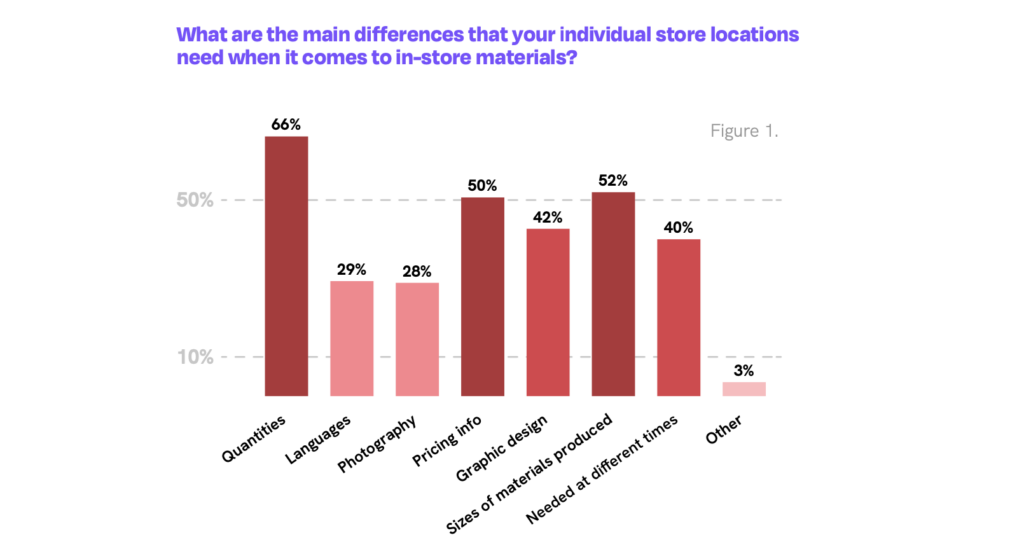In-store Marketing Personalisation: How to implement it at scale.


Nothing captures someone’s attention more than a message tailored specifically to them. And shoppers now expect a degree of personalisation. However, while this is easy with digital advertising campaigns, in-store marketing remains a one-size-fits-all approach. So, with shoppers now expecting greater personalisation, we explored how you can personalise in-store marketing materials.
Generally, it is not possible to personalise in-store marketing campaigns to the same degree as digital ones. However, retailers and brands can localise in-store marketing by identifying dominant customer segments in geographic regions and distributing targeted messages to specific stores. In-store marketing management tools can automate this process.
So, while in-store marketing personalisation isn’t strictly possible, we can get very close. Let’s explore how you can run localised in-store marketing campaigns.
Marketing localisation is a hot topic. Indeed, 81% of multi-location retailers in North America said they need to distribute different materials to each location. However, 58% of total respondents said that distributing materials to different stores was a significant pain point in 2022. The below chart shows how retailers are localising their campaigns currently.

| Variable | Count | As a % of Total Surveyed |
|---|---|---|
| Quantities | 148 | 66% |
| Languages | 66 | 29% |
| Photography | 65 | 28% |
| Pricing info | 113 | 50% |
| Graphic design | 95 | 42% |
| Sizes of materials | 117 | 52% |
| Needed at different times | 90 | 42% |
| Other | 7 | 3% |
When asked about the main differences in their campaigns, 66% of respondents are already minimizing waste by sending different quantities of materials to each store. Additionally, 52% of respondents send different sizes of materials to each location, while 40% send materials to stores at different times.
These results demonstrate that retailers are taking steps to reduce waste and ensure the right materials are going to each location. However, 72% of marketers said that producing one round of marketing materials requires a significant amount of time and labour.
Meanwhile, approximately one-third of retailers are localising the messaging, design and offers of their materials. Distributing materials with different pricing to each location was top of the list (50%), while graphic design (43%), language (29%), and photography (29%) were common changes to materials in different stores.
While most retailers we spoke to indicated a desire to tailor messaging to different customer segments in each location, very few had a clear process for implementing such granular distribution. Only 40% of marketers could quickly determine the requirements for each store.
So, retailers are already starting to localise materials, but it remains a challenge. Understanding the demographics and buying segments in local areas around certain stores is data most retailers already have. The next step is to act upon it.
Let’s suppose you own a chain of restaurants in France. You might find that, while your seaside location in Brittany has a car park and large outdoor dining area, your eatery in central Paris is barely big enough for eight tables – let alone promotional posters and banners advertising children can now eat for free.
While both these locations need to be on brand, they will attract different types of customers who want different dining experiences. Your eatery in Paris will likely be an intimate setting for couples and probably be highly popular as a cafe. Meanwhile, your seaside location in Brittany will attract families with children for lunch and dinner.
If you promote the same products in the same manner, you will likely appeal to just one audience or neither.
The key is to understand your audience and deliver specific campaigns to each.
While this example demonstrates polar opposite situations, you cannot underestimate the nuances of this in every store. Restaurants like Pizza Express in the UK source local artwork to display in their stores, so they don’t appear as a pure fast-food chain. Meanwhile, hotels will display brochures for local excursions and activities in each location.
Retailers, brands and financial services companies utilise this exceptionally well in their online advertising. With Instagram, Facebook and LinkedIn targeting, we can serve up targeted creative around the interests and demographics of our different customers.
Over 66% of shoppers returning to brick-and-mortar retail post-covid say it’s for the experience. It’s about time we were able to personalise or localise our in-store advertising in the same way we do our digital campaigns.
Many marketers will point to the social media platforms themselves as facilitating this highly targeted advertising approach. However, with the wealth of data and insights available to retailers, it is possible to achieve a similar level of personalisation in stores.
So, here we unpack everything required to execute localised in-store marketing campaigns.
The first step is to review your POS data across multiple stores and identify your customer data. As marketers, you should align with your merchandising team to identify the best-selling products in different stores. This will indicate which products you should promote more in different regions. Particularly for brands, this can indicate areas to increase spending.
Additionally, aim to build customer profiles in each store. If you can identify your buyers in each store, you can begin to look at how to localise them. For example, understanding the dominant culture that shops in that store, the dominant language, and the disposable income levels of shoppers in that area.
You should already have most of this information available within your business and consider it within your in-store marketing.
The next step is to create dynamic store profiles. We cover store profiles in more detail in this article, so we will just share some of the highlights.
Your store profiles should encapsulate everything you need to know to execute effective marketing in your stores. This is where you should include all of the customer data you collected from other areas, and it should form the picture of who shops in your stores.
In addition, you need to map out the fixtures, fittings and features in each store. This will let you know how much space you have in each store for your campaigns. There is no point in creating targeted messaging around customer segments but then distributing them on materials that can’t fit in your stores.

Much like when you build a campaign on LinkedIn, you want to target based on various features, not just one. So, once you’ve compiled all your data into store profiles, you should group your stores into segments based on similarities. This would be more effective if you could operate a tagging system for each store.
We’re trying to replicate the type of targeting you can achieve on LinkedIn or Facebook, where you could run different campaigns for small stores in Spanish-speaking communities, small stores in English-speaking communities, and a different one for larger stores with a broader demographic range.
Creating these segments or tagging stores will make it quicker and easier to execute campaigns at scale. So you’re not manually selecting which stores go into a campaign each time.
Up to this point, we’ve focused on the targeting side of localised marketing campaigns. However, it is perhaps most important to differentiate the creative.
While you may run campaigns in specific stores, it’s more likely that you will run the same campaign in multiple store segments and just want to tweak the creative in each one.
When you create a design within Adobe InDesign and other design platforms, you can set certain editable fields. This allows your design team to create a single on-brand design, with uniform images, fonts and placement of all design components but then allows marketers or store teams to customise a specific part of the design. For example, this could be as simple as changing the store name or as big as changing the headline completely.
If you already execute large digital campaigns, you may already use a tool such as Wave2 (or a system it’s embedded in) to manage this. Once you know all of the different shapes, sizes and measurements of your in-store marketing fixtures, you should be able to use the same tools for your in-store campaigns.
You will also need to consider your creative process when doing this at scale. Many teams use a project management tool, which is ok. But with multiple designs and different stakeholders, managing artwork and revisions is key. We recommend implementing an artwork approval system and digital asset management (DAM) system.

Bringing all these components together, you now need to distribute the right materials with the right messages to the right stores. This is Store-specific distribution.
Provided all of your information up to this point has been structured accurately, the stock ordering should be fairly simple.
Additionally, when managing your data, you always need the store that each design is going to in mind – this could be on your spreadsheet or linked to a database. But if you lose that association, you will have to go through all your information and identify missing or incorrect fields. It can make the whole process take a lot longer.
Some printers will offer to do this for you, but we recommend that retailers take control of this. When brick-and-mortar stores are critical to your revenue model, it’s worth maintaining control over how you drive shoppers to action.
The final step is ensuring that all your camping materials are delivered, implemented and maintained throughout the campaign lifecycle. You need a robust method for auditing your marketing campaigns to ensure they are implemented as planned.
Many marketers invest in great in-store campaigns and initiatives to drive in-store revenues but struggle to ensure the execution matches the plan. This leads to lost revenues as displays can’t fulfil their intended purposes.
Implement these simple steps with each campaign to maintain compliance:
This methodology helped Paddy Power improve display compliance from 42% to 100%. Read more about it here.
This manual process may be manageable for you in up to 20 stores, but if you are serious about implementing personalised marketing campaigns, then automating this process is critical.
Colateral provides in-store marketing automation software to manage all of your marketing in physical spaces.
We make it easy for you to execute targeted campaigns in different stores. You simply need to gather your store data, decide on your campaign objectives and design your campaign creative. Then Colateral automates the rest to ensure your campaigns are executed accurately.
Working with a DIY Retailer in the UK, we enabled them to save 80% of their time by automating their in-store marketing. Now a 1-person marketing team manages in-store marketing across 100 stores, and they can focus on localised campaigns that drive more revenues.
For weekly tips to improve your in-store marketing, subscribe to our blog.
Or, get in touch to discuss your in-store marketing personalisation with one of our team.
 Thought Leadership
Thought Leadership
With the hype surrounding e-commerce and direct-to-consumer, it's easy to lean towards these channels when...
 Case Study
Case Study
In 2018, Paddy Power was looking to streamline its in-store marketing process. The hefty workload...